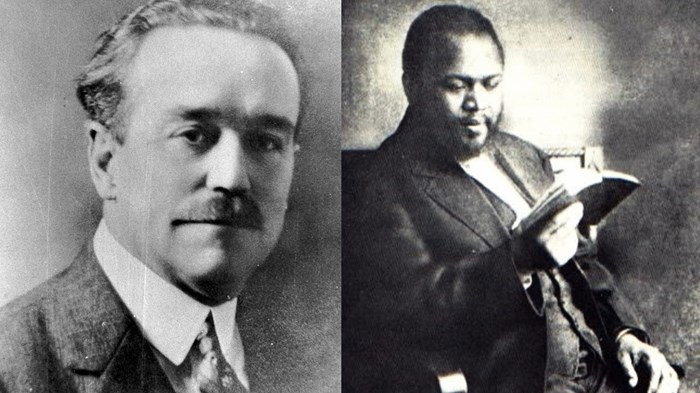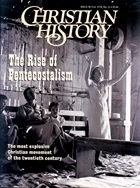
The fact that Pentecostalism has two founders—one white (Charles Parham), one black (William Seymour)—did not go unnoticed. It perfectly signified the interracial cooperation of the movement's early days, both at Azusa Street and in the new denominations. Not only did blacks and whites worship together with other races and ethnic groups, but many racists were transformed and prejudices were challenged.
Sadly, Parham's bigoted tendencies were not among these. He caricatured Seymour's "disgusting" Azusa Street revivals as "Southern darkey camp meetings." The short-lived relationship between Seymour and Parham foreshadowed the inability of Pentecostalism to maintain the racial harmony for very long. What emerged from the failed experiment, however, was a distinct movement. Neither that movement, black Pentecostalism, nor the larger movement, Pentecostalism, can be understood without knowing the early relationships between black and white Pentecostals.
Christian History asked David Daniels of McCormick Seminary (Chicago) to help us understand that complex relationship.
Black Pentecostalism emerged out of three nineteenth-century renewal movements within the black church: the black Holiness movement, the black Restorationist movement, and the healing movement—and all three had from the beginning a desire to bring blacks and whites together.
The black Holiness movement arose during the decades before the Civil War but only developed institutions in 1869 when the first black Holiness denomination was formed: the Reformed Zion Union Apostolic Church. The early movement was mainly found among black Methodist congregations from North Carolina to New York, but soon the movement spread, invading black Baptist and independent religious circles across the country. By the late 1800s, many black Holiness leaders were forging cooperation with white leaders throughout the country.
William Christian, who founded the "Church of the Living God, Christian Workers for Fellowship" in 1888 near Wrightsville, Arkansas, led the black Restorationist movement. He sought to popularize the teachings of Alexander Campbell: he rejected denominationalism and aimed to teach only the simple message of Christ; he had no patience with unscriptural titles for churches, specifically the terms Baptist and Methodist. He also advocated the reform of popular conversion practices, such as the mourner's bench: "All the praying to repent and the mourners' bench business [is all] ignorance of the deepest dye. You don't have to have any fits and spasms, but just accept the Word and he will save you."
By 1900 the denomination included nearly 90 congregations in 11 states, and a cardinal principle of Christian's message was the rejection of racial prejudice.
There were two streams in the black healing movement. An older stream offered prayers for healing, teaching that the healing could occur over time or instantaneously. A newer stream was led by Elizabeth Mix, the first African-American female to serve as full-time healing evangelist. Mix emphasized the role of faith in healing:
"'According to your faith' so be it unto you. Lay aside trusting in the 'arm of flesh' and lean wholly upon God and his promises." Unique in Mix's ministry was that she worked with all races.
In the early 1900s, these three movements joined the parallel movements found in white renewal groups to produce the Azusa Street Revival and a strong interracial impulse within Pentecostalism.
The power of Jim Crow
The early years of the Azusa Street Revival were a model of interracial cooperation, partly due to interracial ideals that had been preached in both black and white Holiness churches. Not only the participants, but the leadership at Azusa was a mix of black and white.
So impressive was this model that by 1910, prominent black and white Pentecostal leaders were campaigning to make the interracial vision of the Azusa Street Revival a keystone of Pentecostalism. Black Holiness congregations in Los Angeles, Portland, Memphis, Indianapolis, and New York City introduced Pentecostalism to these cities, conspicuously modeling the interracial worship brought from Los Angeles.
The most eminent African-American Holiness fellowship, The Church of God in Christ (COGIC), led by Charles Harrison Mason, brought in two white fellowships in an attempt to become more integrated.
The Pentecostal Assemblies of the World (PAW), established in 1907, also incorporated a large influx of whites who withdrew from the Assemblies of God in the Oneness dispute.
While COGIC and PAW continued to attract white members (throughout the twentieth century, in fact), many white leaders within Pentecostalism found it difficult to maintain the interracial impulse. Social Darwinism, Jim Crowism, and racism prevailed in this era, a mere half century after the Civil War. Racial segregation was a virtue. Many denominations staunchly committed to interracial church conventions found insurmountable problems when planning meetings: Jim Crow laws in the South prohibited multiracial conventions and hotel accommodations—although COGIC continued to hold interracial conventions in Memphis up until the mid-1930s.
Because of the social and cultural obstacles to the interracial ideal (and also because some denominations would not allow black leadership), black congregations began withdrawing from multiracial denominations as early as 1908. Similarly, one white fellowship associated with COGIC formed the Assemblies of God as a predominately white fellowship in 1914. Ten years later, the majority of white congregations in the PAW withdrew to form a predominately white denomination eventually named the United Pentecostal Church.
Though many blacks and whites submitted to the segregationist outlook of the day, what is surprising is that, in spite of the huge challenges, some whites and blacks continued to strive to realize the interracial ideal. Most black Pentecostals believed the "cleavage of the races" was one of Pentecostalism's chief issues and believed it was "sinful and embarrassing." In 1918 the COGIC made interracial fellowship an essential teaching of their church manual, in a section titled, Equal in Power and Authority. After noting segregationist tendencies (how some denominations "advised electing colored officials to preside over colored assemblies") and injustice (how blacks were denied "equal power with white bishops"), it stated its position clearly: "The Church of God in Christ recognizes the fact that all believers are one in Christ Jesus and all its members have equal rights. Its overseers, both colored and white, have equal power and authority in the church."
Today, however, black Pentecostalism remains a distinct, though vibrant, branch of the larger movement, with dozens of denominations and millions of believers. Since the late 1960s, Pentecostal denominations have attempted to heal some of these divisions. More and more Pentecostals today hold tightly to the interracial dream which, as one church document put it, has more than ever "awakened greater hopefulness" in terms of solving race problems.
David D. Daniels is associate professor of church history at McCormick Seminary, Chicago.
Copyright © 1998 by the author or Christianity Today/Christian History magazine.
Click here for reprint information on Christian History.

Support Our Work
Subscribe to CT for less than $4.25/month





























